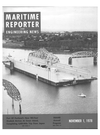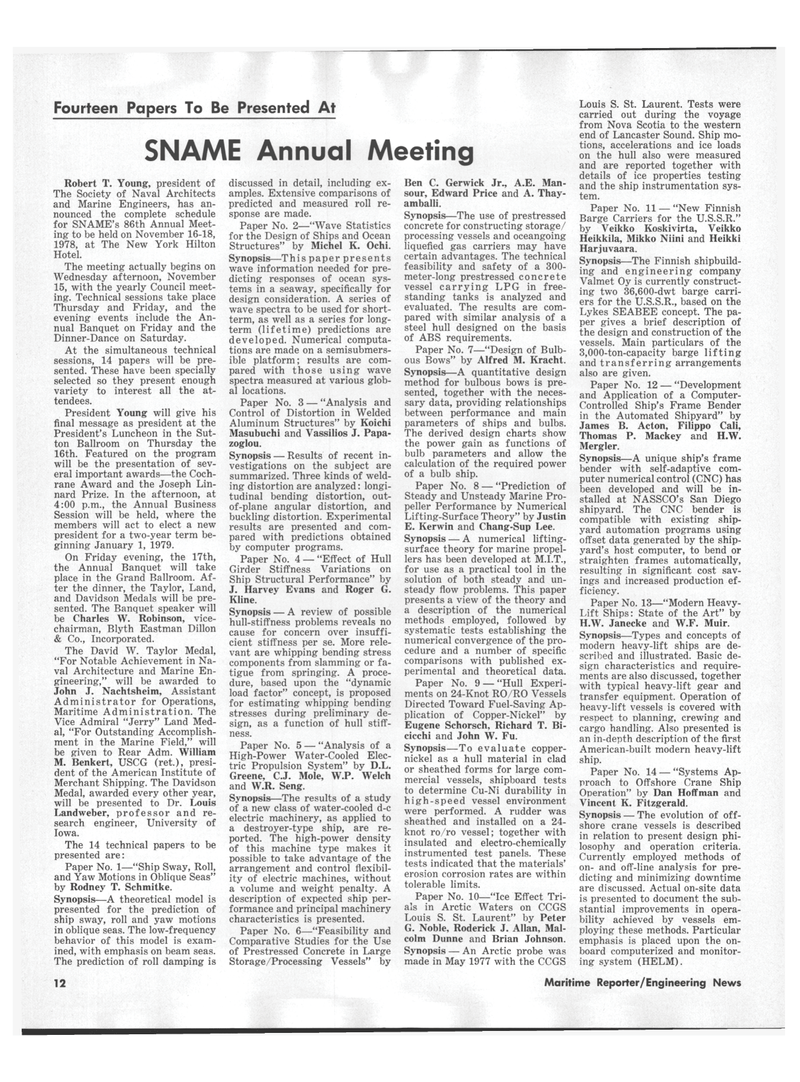
Page 12: of Maritime Reporter Magazine (November 1978)
Read this page in Pdf, Flash or Html5 edition of November 1978 Maritime Reporter Magazine
Fourteen Papers To Be Presented At
SNAME Annual Meeting
Robert T. Young, president of
The Society of Naval Architects and Marine Engineers, has an- nounced the complete schedule for SNAME's 86th Annual Meet- ing to be held on November 16-18, 1978, at The New York Hilton
Hotel.
The meeting actually begins on
Wednesday afternoon, November 15, with the yearly Council meet- ing. Technical sessions take place
Thursday and Friday, and the evening events include the An- nual Banquet on Friday and the
Dinner-Dance on Saturday.
At the simultaneous technical sessions, 14 papers will be pre- sented. These have been specially selected so they present enough variety to interest all the at- tendees.
President Young will give his final message as president at the
President's Luncheon in the Sut- ton Ballroom on Thursday the 16th. Featured on the program will be the presentation of sev- eral important awards—the Coch- rane Award and the Joseph Lin- nard Prize. In the afternoon, at 4:00 p.m., the Annual Business
Session will be held, where the members will act to elect a new president for a two-year term be- ginning January 1, 1979.
On Friday evening, the 17th, the Annual Banquet will take place in the Grand Ballroom. Af- ter the dinner, the Taylor, Land, and Davidson Medals will be pre- sented. The Banquet speaker will be Charles W. Robinson, vice- chairman, Blyth Eastman Dillon & Co., Incorporated.
The David W. Taylor Medal, "For Notable Achievement in Na- val Architecture and Marine En- gineering," will be awarded to
John J. Nachtsheim, Assistant
Administrator for Operations,
Maritime Administration. The
Vice Admiral "Jerry" Land Med- al, "For Outstanding Accomplish- ment in the Marine Field," will be given to Rear Adm. William
M. Benkert, USCG (ret.), presi- dent of the American Institute of
Merchant Shipping. The Davidson
Medal, awarded every other year, will be presented to Dr. Louis
Landweber, professor and re- search engineer, University of
Iowa.
The 14 technical papers to be presented are:
Paper No. 1—"Ship Sway, Roll, and Yaw Motions in Oblique Seas" by Rodney T. Schmitke.
Synopsis—A theoretical model is presented for the prediction of ship sway, roll and yaw motions in oblique seas. The low-frequency behavior of this model is exam- ined, with emphasis on beam seas.
The prediction of roll damping is discussed in detail, including ex- amples. Extensive comparisons of predicted and measured roll re- sponse are made.
Paper No. 2—"Wave Statistics for the Design of Ships and Ocean
Structures" by Michel K. Ochi.
Synopsis—This paper presents wave information needed for pre- dicting responses of ocean sys- tems in a seaway, specifically for design consideration. A series of wave spectra to be used for short- term, as well as a series for long- term (lifetime) predictions are developed. Numerical computa- tions are made on a semisubmers- ible platform; results are com- pared with those using wave spectra measured at various glob- al locations.
Paper No. 3 — "Analysis and
Control of Distortion in Welded
Aluminum Structures" by Koichi
Masubuchi and Vassilios J. Papa- zoglou.
Synopsis — Results of recent in- vestigations on the subject are summarized. Three kinds of weld- ing distortion are analyzed: longi- tudinal bending distortion, out- of-plane angular distortion, and buckling distortion. Experimental results are presented and com- pared with predictions obtained by computer programs.
Paper No. 4 — "Effect of Hull
Girder Stiffness Variations on
Ship Structural Performance" by
J. Harvey Evans and Roger G.
Kline.
Synopsis — A review of possible hull-stiffness problems reveals no cause for concern over insuffi- cient stiffness per se. More rele- vant are whipping bending stress components from slamming or fa- tigue from springing. A proce- dure, based upon the "dynamic load factor" concept, is proposed for estimating whipping bending stresses during preliminary de- sign, as a function of hull stiff- ness.
Paper No. 5 — "Analysis of a
High-Power Water-Cooled Elec- tric Propulsion System" by D.L.
Greene, C.J. Mole, W.P. Welch and W.R. Seng.
Synopsis—The results of a study of a new class of water-cooled d-c electric machinery, as applied to a destroyer-type ship, are re- ported. The high-power density of this machine type makes it possible to take advantage of the arrangement and control flexibil- ity of electric machines, without a volume and weight penalty. A description of expected ship per- formance and principal machinery characteristics is presented.
Paper No. 6—"Feasibility and
Comparative Studies for the Use of Prestressed Concrete in Large
Storage/Processing Vessels" by
Ben C. Gerwick Jr., A.E. Man- sour, Edward Price and A. Thay- amballi.
Synopsis—The use of prestressed concrete for constructing storage/ processing vessels and oceangoing liquefied gas carriers may have certain advantages. The technical feasibility and safety of a 300- meter-long prestressed concrete vessel carrying LPG in free- standing tanks is analyzed and evaluated. The results are com- pared with similar analysis of a steel hull designed on the basis of ABS requirements.
Paper No. 7—"Design of Bulb- ous Bows" by Alfred M. Kracht.
Synopsis—A quantitative design method for bulbous bows is pre- sented, together with the neces- sary data, providing relationships between performance and main parameters of ships and bulbs.
The derived design charts show the power gain as functions of bulb parameters and allow the calculation of the required power of a bulb ship.
Paper No. 8 — "Prediction of
Steady and Unsteady Marine Pro- peller Performance by Numerical
Lifting-Surface Theory" by Justin
E. Kerwin and Chang-Sup Lee.
Synopsis — A numerical lifting- surface theory for marine propel- lers has been developed at M.I.T., for use as a practical tool in the solution of both steady and un- steady flow problems. This paper presents a view of the theory and a description of the numerical methods employed, followed by systematic tests establishing the numerical convergence of the pro- cedure and a number of specific comparisons with published ex- perimental and theoretical data.
Paper No. 9 — "Hull Experi- ments on 24-Knot RO/RO Vessels
Directed Toward Fuel-Saving Ap- plication of Copper-Nickel" by
Eugene Schorsch, Richard T. Bi- cicchi and John W. Fu.
Synopsis—To evaluate copper- nickel as a hull material in clad or sheathed forms for large com- mercial vessels, shipboard tests to determine Cu-Ni durability in high-speed vessel environment were performed. A rudder was sheathed and installed on a 24- knot ro/ro vessel; together with insulated and electro-chemically instrumented test panels. These tests indicated that the materials' erosion corrosion rates are within tolerable limits.
Paper No. 10—"Ice Effect Tri- als in Arctic Waters on CCGS
Louis S. St. Laurent" by Peter
G. Noble, Roderick J. Allan, Mal- colm Dunne and Brian Johnson.
Synopsis — An Arctic probe was made in May 1977 with the CCGS
Louis S. St. Laurent. Tests were carried out during the voyage from Nova Scotia to the western end of Lancaster Sound. Ship mo- tions, accelerations and ice loads on the hull also were measured and are reported together with details of ice properties testing and the ship instrumentation sys- tem.
Paper No. 11 — "New Finnish
Barge Carriers for the U.S.S.R." by Veikko Koskivirta, Veikko
Heikkila, Mikko Niini and Heikki
Harjuvaara.
Synopsis—The Finnish shipbuild- ing and engineering company
Valmet Oy is currently construct- ing two 36,600-dwt barge carri- ers for the U.S.S.R., based on the
Lykes SEABEE concept. The pa- per gives a brief description of the design and construction of the vessels. Main particulars of the 3,000-ton-capacity barge lifting and transferring arrangements also are given.
Paper No. 12 — "Development and Application of a Computer-
Controlled Ship's Frame Bender in the Automated Shipyard" by
James B. Acton, Filippo Cali,
Thomas P. Mackey and H.W.
Mergler.
Synopsis—A unique ship's frame bender with self-adaptive com- puter numerical control (CNC) has been developed and will be in- stalled at NASSCO's San Diego shipyard. The CNC bender is compatible with existing ship- yard automation programs using offset data generated by the ship- yard's host computer, to bend or straighten frames automatically, resulting in significant cost sav- ings and increased production ef- ficiency.
Paper No. 13—"Modern Heavy-
Lift Ships: State of the Art" by
H.W. Janecke and W.F. Muir.
Synopsis—Types and concepts of modern heavy-lift ships are de- scribed and illustrated. Basic de- sign characteristics and require- ments are also discussed, together with typical heavy-lift gear and transfer equipment. Operation of heavy-lift vessels is covered with respect to planning, crewing and cargo handling. Also presented is an in-depth description of the first
American-built modern heavy-lift ship.
Paper No. 14 — "Systems Ap- proach to Offshore Crane Ship
Operation" by Dan Hoffman and
Vincent K. Fitzgerald.
Synopsis — The evolution of off- shore crane vessels is described in relation to present design phi- losophy and operation criteria.
Currently employed methods of on- and off-line analysis for pre- dicting and minimizing downtime are discussed. Actual on-site data is presented to document the sub- stantial improvements in opera- bility achieved by vessels em- ploying these methods. Particular emphasis is placed upon the on- board computerized and monitor- ing system (HELM). 12 Maritime Reporter/Engineering News

 11
11

 13
13
